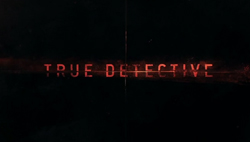Murder in Lost Carcosa

Something left this guy in tatters…
I finally sat down and watched the first season of True Detective, only some six months after I first mentioned intending to. For me, that’s not a bad turn-around time.
It’s a good show, well worth watching. But I’m not actually here to talk about the ups and downs of the show itself. I enjoyed it, and if you like detective stories, you might enjoy it as well.
But we all know the real reason I was interested in watching it – I was curious about the buzz it generated for referencing The King in Yellow. And on that score I have mixed feelings.
Oh, I should offer a sort of spoiler warning at this point. I don’t intend to get into specifics or discuss anything plot related, but if you read what I say below, you’re likely to figure out a few things ahead of when you might normally do so. I’d hate for anyone to blame me for that. Also, you absolutely do not need to read the book to understand the show.
So, consider this spoiler space.
Now, then.
First, there are no direct references to the fictitious play, The King in Yellow. It may be that a copy was lying about in the background of a scene, but if so, I didn’t see it. (If you did, please tell me below.)
Second, I enjoyed the subtle introduction of the Yellow King, and the idea that those who knew of it fell to raving. It was handled in the background. Not really shown – or at least nothing like shown – until late in the season, at which point the degree of rambling was somewhat more … tame than implied early on. Also, the king himself was never identified with a character, which was probably a good choice.
All told, the Yellow King references set the stage well.
Third, the Yellow Sign. I really dug the way they depicted the Yellow Sign. First of all, they never used the phrase “Yellow Sign.” There was no need to. It was enough to simply show it, on people, on places, formed by flying birds… When they needed to call it anything, they just called it “their sign.” Very effective.
Fourth, there were references to Carcosa. I appreciated those references, even if they were a bit jumbled. Given the idea of people exposed to the tattered king being less than completely sane, it makes a certain amount of sense that they would be inconsistent.
But … as a geek, I found their use of Carcosa a bit of a letdown. Carcosa is described by Chambers in most poetic fashion. I wanted to see some of that.
Along the shore the cloud waves break,
The twin suns sink beneath the lake,
The shadows lengthen
In Carcosa.
Strange is the night where black stars rise,
And strange moons circle through the skies
But stranger still is
Lost Carcosa.
Songs that the Hyades shall sing,
Where flap the tatters of the King,
Must die unheard in
Dim Carcosa.
Song of my soul, my voice is dead;
Die thou, unsung, as tears unshed
Shall dry and die in
Lost Carcosa.
— Robert W. Chambers, The King in Yellow
I have to say, though, that any complaints I have there are nitpicking. They did several things right with Carcosa. They left it mysterious. They never explained it, never talked about its origins, never attempted to make it mundane.
And then, toward the end of the season, when they finally revealed a place called Carcosa by a key character, it was creepy as hell. The writers handled the essence of it well, even if they didn’t take more from the original book than inspiration.
Which, I suppose, is fair to say about the show itself and its handling of The King in Yellow.
That’s what I think, anyway. What do you think? Let me know below.

